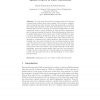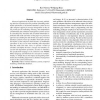355 search results - page 2 / 71 » Support for Temporal Data by Complex Objects |
SIGMOD
2000
ACM
13 years 9 months ago
2000
ACM
We consider spatio-temporal databases supporting spatial objects with continuously changing position and extent, termed moving objects databases. We formally define a data model f...
DAWAK
2011
Springer
12 years 5 months ago
2011
Springer
In recent years, there has been a large increase in the amount of spatial data obtained from remote sensing, GPS receivers, communication terminals and other domains. Data warehous...
ICMCS
1994
IEEE
13 years 9 months ago
1994
IEEE
Advanced applications in fields like electronic publishing and telecooperation face the problem of handling multimedia information. Conventional database systems do not offer adeq...
EDBT
2006
ACM
14 years 5 months ago
2006
ACM
Advances of sensor and RFID technology provide significant new power for humans to sense, understand and manage the world. RFID provides fast data collection with precise identific...
ICDM
2006
IEEE
13 years 11 months ago
2006
IEEE
A Spatio-Temporal Association Rule (STAR) describes how objects move between regions over time. Since they describe only a single movement between two regions, it is very difficu...


